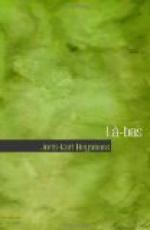“But Dr. Johannes does not cure all sufferers, without discrimination?”
“No. He will not meddle with any ailments which are not the result of spells. He says he can do nothing with natural ills, which are the province of the physician. He is a specialist in Satanic affections. He has most to do with the possessed whose neuroses have proved obdurate to hydrotherapeutic treatment.”
“What does he do with the precious stones you mentioned?”
“First, before answering your question, I must explain the significance and virtue of these stones. I shall be telling you nothing new when I say that Aristotle, Pliny, all the sages of antiquity, attributed medical and divine virtues to them. According to the pagans, agate and carnelian stimulate, topaz consoles, jasper cures languor, hyacinth drives away insomnia, turquoise prevents falls or lightens the shock, amethyst combats drunkenness.
“Catholic symbolism, in its turn, takes over the precious stones and sees in them emblems of the Christian virtues. Then, sapphire represents the lofty aspirations of the soul, chalcedony charity, sard and onyx candor, beryl allegorizes theological science, hyacinthe humility, while the ruby appeases wrath, and emerald ‘lapidifies’ incorruptible faith.
“Now in magic,” Des Hermies rose and took from a shelf a very small volume bound like a prayer book. He showed Durtal the title: Natural magic, or: The secrets and miracles of nature, in four volumes, by Giambattista Porta of Naples. Paris. Nicolas Bonjour, rue Neuve Nostre Dame at the sign Saint Nicolas. 1584.
“Natural magic,” said Des Hermies, “which was merely the medicine of the time, ascribes a new meaning to gems. Listen to this. After first celebrating an unknown stone, the Alectorius, which renders its possessor invincible if it has been taken out of the stomach of a cock caponized four years before or if it has been ripped out of the ventricle of a hen, Porta informs us that chalcedony wins law suits, that carnelian stops bloody flux ’and is exceeding useful to women who are sick of their flower,’ that hyacinth protects against lightning and keeps away pestilence and poison, that topaz quells ‘lunatic’ passions, that turquoise is of advantage against melancholy, quartan fever, and heart failure. He attests finally that sapphire preserves courage and keeps the members vigorous, while emerald, hung about one’s neck, keeps away Saint John’s evil and breaks when the wearer is unchaste.
“You see, antique philosophy, mediaeval Christianity, and sixteenth century magic do not agree on the specific virtues of every stone. Almost in every case the significations, more or less far-fetched, differ. Dr. Johannes has revised these beliefs, adopted and rejected great numbers of them, finally he has, on his own authority, admitted new acceptations. According to him, amethyst does cure drunkenness; but moral drunkenness, pride; ruby relieves sex pressure; beryl fortifies the will; sapphire elevates the thoughts and turns them toward God.




